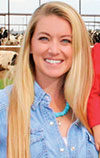While I have lived and farmed in New Mexico all my life, my family originally dairy farmed in California. In the 1980s and early 1990s, there was a “great migration” of dairies from California to New Mexico, and we were one of those families.
People often assume we moved our dairy from California to New Mexico to avoid environmental regulations, but that isn’t quite the case.
Did you know that New Mexico has some of the strictest groundwater quality regulations in the U.S.? We have been dealing with new regulations called the “New Dairy Rule” for the last couple of years. As an environmental scientist, I am seeing more of these changes across the country.
Most of you know about the court rulings in the Northwest, which resulted in significant legal and technical costs to producers. And if you are like me, you are concerned how those rulings will affect the rest of the country. These changes pose many challenges and financial hardships for our dairy farmers.
New requirements such as new monitoring wells, synthetically lined lagoons and additional metering can make the costs add up. Environmental consultants are not always producers’ favorite people to deal with. Environmental changes are often seen as a cost output with no financial benefits in return.
But like most producers I work with, I want to protect my land and water just as much, if not more, than anyone else. My family and I live here and drink this water every day. What we may disagree on is how to best protect our resources.
One problem I see on many dairies is the changing of technologies and new methods. When you are working on a dairy that is 50-plus years old (or older), there may have been best management practices used in the past that were approved by the regulators and are now seen as not protective of water quality.
One regulator may have required a certain type of liner or well design, only for the regulations to change a couple years after the producer has already installed the equipment. Now, years later, a producer is dealing with the repercussions of that practice or equipment. Whose fault is that, and who is going to cover the additional costs?
There are programs such as the Environmental Quality Incentives Program (EQIP) that can assist with these financial burdens to make improvements, but it is often easier said than done. We need our regulators to base their decisions on sound science and not be influenced by the fear tactics of anti-ag groups.
Another challenge we need to overcome as an industry is our fear of working hand in hand with regulators. I spent a week at EPA’s National CAFO Roundtable, and I quickly learned that these regulators don’t know us or our story or understand our passion for what we do.
This scared me and other farmers. I know many producers are afraid if they submit all their data and reports and an issue comes up, the dairy farmer will be the first to blame. I think we as a whole – producers, regulators and consultants – need to change this attitude. When a problem arises, regulators need to, first and foremost, be there to offer suggestions and solutions, not push the blame onto the farmers.
Producers also need to understand that data is valuable. Data tells your story. If you are regularly sampling wells, metering water use, soil sampling and tracking management practices and improvements, it makes it a lot easier for me as a consultant to explain the dairy’s environmental history. If there is no data, anyone can write your story, and they can say whatever they want, and you have no data to protect yourself.
I have been working on a dairy that is undergoing a site remediation because of an overapplication issue from a previous owner. We have been making many management changes, and we have years of data compiled into our online database. Because our proactive management practices have been adopted by the producers, we have seen a drastic improvement in groundwater quality.
While this was a huge problem, it was such a great feeling to use the data to tell the dairy’s story to the regulators and have them see the changes we are making have a positive impact.
A few of my hopes for the future as an environmental scientist and as a dairy farmer, are to bring some common ground to the discussions between regulators and producers. I also hope producers will begin to see the value in updating their environmental management practices.
I hope regulators will understand the hardships and challenges we as producers face everyday. I know we are all working toward the same goal of protecting our resources. We all need to work together; producers, regulators and communities so that farmers can continue to provide food for our nation. ![]()
Follow Tara at her blog: New Mexico Milkmaid.

-
Tara Vander Dussen
- Environmental Scientist - Glorieta Geoscience
- Dairy Producer - Clovis, New Mexico










